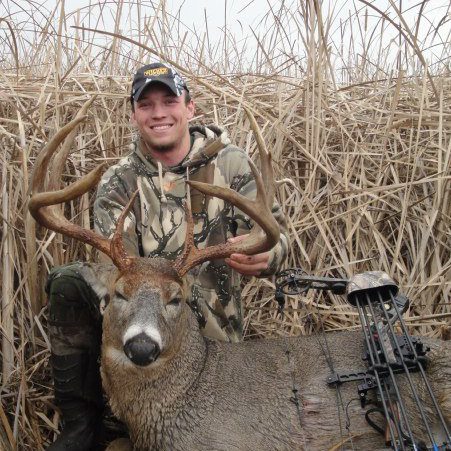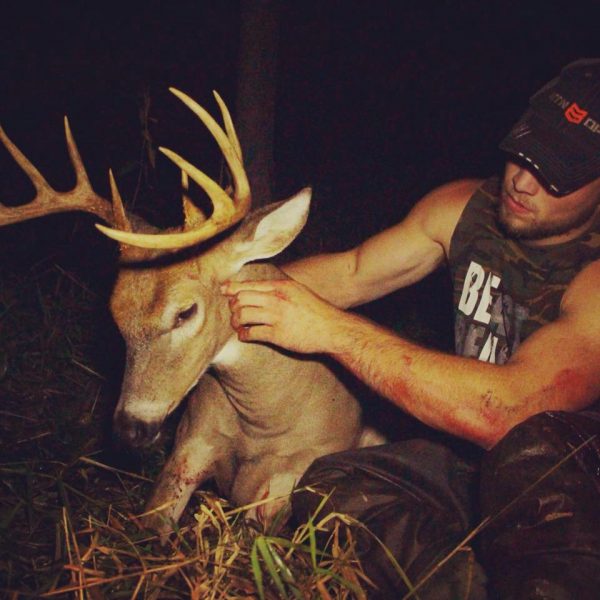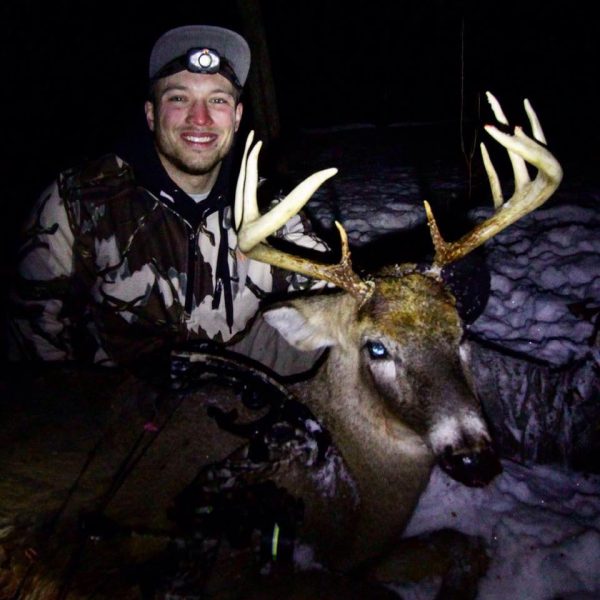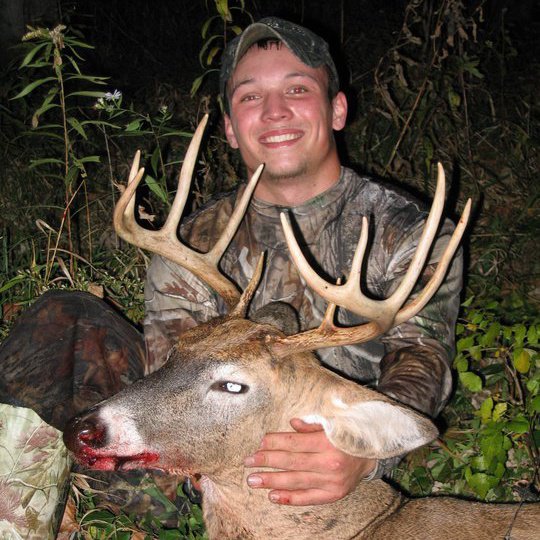Andy May is one of the best DIY whitetail hunters I know and in this upcoming blog series he’s sharing with us, he’s going to be interviewing some of the best DIY hunters HE knows – to dig into exactly what the best DIY/public land whitetail hunters do to find success. It’s sure to be enlightening and Andy kicks things off today with a great profile. Enjoy. – MK
By Andy May
This DIY deer hunter profile series will feature Q & A interviews with some of the best DIY hunters that I’ve come across. They all hunt public land or permission land where they are competing with other hunters. None of these guys own or lease land. They hunt the land that anyone can hunt by knocking on a few doors or find on public ground where competition is high. Still, they get it done year in and year out and they do it in a way that is all their own. To kick off this series, I’ve interviewed Curtis Zabel.
Curtis Zabel

I first met Curtis on a hunting forum called “The Hunting Beast”. It’s home to a bunch of solid DIY type hunters. I’ve gotten to watch Curtis grow into quite the hunter the last few years, but what struck me most about Curtis was his inner drive. He sets goals and by damn he goes and makes it happen. He has been very consistent the last several years and he is hunting all public land. He loves to document his hunts and share with others and I find his no quit attitude, positive outlook and his love for sharing his adventures in the outdoors extremely motivating. In fact at the end of this season when I wasn’t in it mentally any more, I saw Curtis pound away at public land right until the very end. It motivated me to get off my sorry butt and wouldn’t you know it, Curtis wrapped his tag around a beautiful last minute whitetail. Here’s my recent Q&A with him in which we discuss many of the factors related to how he hunts public land whitetails and how he ultimately finds success.
Q: Tell me about the places you hunt.
A: Right now I am hunting 100% public property. I’ve hunted small permission chunks here in WI over the past years but it always seemed as though I was limited. I had to share it with others; I couldn’t do things the way I wanted to. I felt like I always owed someone for letting me onto their property and I hate that feeling. I’ve been taken advantage of, kicked off a week before season, etc. I really like to rely on just myself and also not limit myself. I’ve found throughout the years I’ve spent a lot of time focusing on certain private chunks, running cameras, and hunting those pieces too much because they required less effort than a lot of my public spots.
The majority of the public land I hunt here in WI is real wet/marshy terrain – cattail marshes, cedar swamps, bogs, river bottoms, etc. I also hunt hilly/bluff terrain in western WI and I’m starting to fall in love with that more and more, even though the wind can be a pain in the rear end sometimes. I hunt all over the state of WI, but not so much the northern regions. I like to stack the odds in my favor and the deer population isn’t sufficient enough for me to spend any time up there. The majority of my hunting is in Central, SW, and W WI. Honestly I don’t think hunting pressure is too bad around here. I think a lot of people get turned off by lots of cars in the parking lots and think a piece is over hunted. That’s where scouting comes in to play big for me. If you find how they are moving through the area to stay safe from other hunters it’s really not that big of a deal. You will find pockets and certain areas that you can kill deer. Also certain times of the year are key – some spots suck 90% of the time but if you know when to hunt the spot it can be killer. That all depends on pressure, time of year, and food sources. To sum it up I guess, there are a lot of areas around here that are hunted pretty heavily and it is pretty much impossible to have a spot all to yourself, but if you play the game right and hunt smart, hitting certain spots during certain times of the year, a guy can be successful every year.
I just recently started to venture out of state and it is one of the best decisions I’ve ever made. My favorite thing to do is travel, explore, scout, and find new areas to hunt. Hunting new terrain, learning how deer move through different areas, experiencing the difference between states as far as hunting pressure and how deer survive. Two years ago I decided to hunt public land in Missouri after tagging out here in WI early season. Our video ‘Missouri Blood‘ on our Youtube channel shows the entirety of the hunt and I look forward to a lot more hunts like that in the future. Iowa will be in the works this year if I can draw a tag. I would love to experience hunting not just whitetail but other game as well and I’m actually afraid of hunting out West because of what I’ve heard, I will most likely fall in love and not want to come back to Wisconsin.
Q: What motivates you?
A: Doing what I love for a living, not just hunting, but producing videos/films, motivating and inspiring others through my camera lens.
Knowing that I only have one life. Knowing how lucky I am to be in this country (home of the free because of the brave), in the beautiful state of WI. So many people have sacrificed so much fighting for our freedoms; so many people are unable to do what I do, due to illness/injuries. Why would I not want to give my 100% into what I’m passionate and what I love to do? I feel like I owe it to all of those people to give my 100%.
Nay Sayers, people that say things can’t be done. Let me prove you wrong. 🙂
Big bucks…honestly what’s more motivating than a mature slob mega buck crunching through the leaves on a frosty November morning!?
Q: What has been your most effective tool to get big bucks on the ground consistently?
A: Determination hands down is my most effective tool. I’m an average guy. I don’t have lots of money. I work 40+ hrs a week. I don’t think I have any special talents, it’s just the determination I have that puts down bucks. I spend a lot of time and money, and sacrifice a lot to hunt as much as I do.
Q: What type of areas do you look for?
A: I like to look for public chunks that are connected to large areas of managed private property. THICK areas, the thicker the better for the most part. Cattails, cedar swamps, tamarack swamps, thick nasty ridge tops full of lots of thorns.
If you have to cross rivers, a bog or wet mucky swamps, it will most usually cut down the human pressure. Kayak or boat access is always good too.
I’ve had luck on really small chunks and really large chunks of public, it takes a lot of ground work. If you have to walk more than a mile from any given direction from a parking lot it will usually hold deer at some point throughout the year. If I’m out scouting I’m bypassing the majority of the open areas. Open hardwoods. Areas with a lot of human sign, ribbons, stands, cams, cut trails, etc.
If I’m looking for places to hunt in hill country I’m mainly looking for areas with steep hills, and again THICK underbrush. I’ve always had good luck in coniferous areas…hills or swamps it doesn’t matter. I think cedars and tamaracks are big buck magnets.
Q: In your opinion what are some of the key things that you do differently that allow you to succeed when most hunters fail?
A: Determination and the drive to succeed. I think a lot people give up too easily. It’s pretty easy to have a positive attitude when everything is going your way but when things take a turn for the worse it’s a different story. When you spend an hour packing in, an hour setting up camera gear/stand, hunt and don’t see a deer, pack up and out in the dark with a shitty walk on top of that – it’s hard for people to do that consistently without saying giving up. I would be lying if I said a lot of the walks in and packs out weren’t absolutely horrible, but when you have that end result pictured in your head, when you keep that vision in your head of succeeding, in the end I know all of it will be worth it. Whatever the result, it builds character and is good exercise nonetheless. It really all boils down to how bad do you want it?
Another thing would be my access routes and paying attention to detail. I spend a good amount of time planning my way into the tree I’m hunting. I don’t want to walk anywhere I think deer will walk, obviously. Sometimes there is no way around this but if I have to I will climb up a steep rocky point, weasel my way through a bunch of blow downs, walk through super thick/wet cattails to avoid crossing my path with deer. Also, as far as paying attention to detail, I’m keeping a close eye on where I’m walking even when I’m setting trail cameras and hunting. I try to avoid making foot prints or leaving any kind of human sign behind that will give away where I’m hunting or where my trail cameras are. I also look for other human sign very closely. Most of the time when I start seeing human sign in areas, I will avoid that area and go onto plan B.
I also like to hunt mobile – unless it’s the rut I will very rarely hunt the same tree twice.
But like I said, I think I’m pretty average. I think most people know a lot of these things so I guess it isn’t really anything that I do differently. It all falls back on determination and not giving up. That’s the biggest one for me.
Q: How would you describe your style of hunting?
A: Public land run and gun – very, very mobile. Early season I do a lot of bed hunting in the marsh targeting specific bucks. As the season progresses I slowly transition over to hunting doe bedding areas, funnels, pinch points, etc. During the rut it is common for me to pack in, set-up, hunt, and pack back up half way through an all day sit to move sometimes even a matter of 50 yards to a different tree where I’ve been seeing deer move.
I try to adapt and change the way I hunt by focusing on what the deer are doing. If I’m hunting early season and I’m seeing deer hitting acorns I’m hunting acorns and trying to think back to areas I’ve scouted that may be full of acorns. If I go out shining and see a bunch of deer hitting beans, I think of bedding areas near bean fields, etc.
This fall I was filming my buddy Skylar during the rut. It was late October/early November and it was hot I think 60s-70’s if I’m not mistaken. Instead of hunting a ridge top between two bedding areas we decided to sneak into a little 40 acre public piece with some major scrapes and trails down on the edge of a creek – figuring they would need water. We ended up seeing I think three or four different bucks that night come down to get a drink. Unfortunately none were what we were looking for.
Q: What pieces of equipment are essential for your style of hunting and directly attribute to your successes?
A: Mobile setup – I use a Lone Wolf and depending on the tree usually 2-6 sticks. Sometimes less, sometimes more, depending on terrain and cover. I think the XOP stands are pretty similar but have never used them.
GPS- A good GPS is essential for me to get in and out of areas without getting lost. When you’re in the middle of a tamarack swamp in the dark I don’t care how savvy you are with directions, you’re bound to get lost. It also is very beneficial for me when scouting. I like to mark pretty much every major bedding area, rubs, scrapes, funnels, pinch points, etc and then I like to load my points onto Google earth and look at the bigger picture. It helps me put everything together better in my head, and helps me plan access and stand locations.
Backpack – I use the Eberlstock X2 backpack. It is a life saver. I pack everything in my side packs, and then pack in all my clothes, stand, sticks on back strapped down with the backpack straps and kwik straps. If I didn’t have that backpack it would make life miserable getting in and out of hard to reach areas.
Carter thumb release – I used to shoot a regular trigger style release and had THE WORST target panic you could imagine. I worked a lot on my shooting but it was always still lingering. I ended up investing in a Carter and man…that thing is killer. One of the best purchases I made in 2015. Real smooth and eliminates most of the target panic for me. Yes it is expensive but it has helped my shooting dramatically.
I don’t like to focus too much on gear. It really isn’t the biggest deal for me. You can sit on a 5 gallon buck and kill a buck with a longbow. I don’t get too caught up with all the scents, calls, etc. Those are the 4 really essential items for me but I think starting out with the less expensive things actually has helped me appreciate the more expensive things and has taught me more about deer hunting in a way. Just don’t get too caught up with the gizmos and gadgets, focus more on hunting and let your own experiences determine what you want to invest in.
Q: One of the things that I find most interesting about you is your drive. You admit you have a lot to learn but you seem to have an inner drive that is very rare. Where does that come from?
A: Honestly bow hunting and filming has been just something that I was hooked on from the very beginning. I remember filming deer ever since I could remember. Riding my bike down to some fields when I was younger, snuck up in some grass and filmed velvet deer with some chinsy handy cam. I would ride home and be so jacked to see these deer, telling all these stories to my mom. I would call my dad just raving about it. I remember making little movies with my friends, editing skateboarding videos on Sony Vegas when we were younger. I think it was always something I enjoyed doing, and when you enjoy something enough it just drives you to learn more and more. My interest in filming plus my passion of hunting just slowly merged throughout the years and here I am still doing it haha.
I’ve always looked up to my dad, my uncles, and my friends. They got me started and there are things that I’ve learned from every one of them. I remember watching a lot of big name deer hunting shows and I always was super motivated watching them – Stan Potts, Dan Fitzgerald, Roger Raglin. But it wasn’t until I watched WKP ‘The Grind’ that I was just super motivated by that film. Todd Pringnitz has been one of my biggest idols after watching that DVD and still is today. Jumping around on leases, hunting giant bucks, passing giant bucks, you can feel the passion and excitement through that DVD. Still one of my very favorite DVDS to watch. After watching that DVD a 100 times, that DVD is what put me on the next level. I wanted to up my game. I sent film into him for years – nothing special at all, but every year he would give me more and more motivation.
I then found the Hunting Beast – Dan Infalt – another idol of mine – big public land hunter. He goes in-depth with all of the work that goes into hunting and that put me again on another level and I can’t thank him and all the other members on that forum enough – Josh, Shawn, YOU (Andy), Eric, Dan, enough. I have met so many good people through my passion for whitetails, I couldn’t be anymore thankful. Talking to you guys on there gave me the extra motivation to finally seal the deal on a buck of a lifetime. It was 2012 I put down Ochocresto a giant 165″ mainframe 8 point on the public lands and captured everything on film (on our youtube channel). That was the year that changed my life and my hunting career. I was finally accepted on the WKP DVD (a dream of mine) and it was all just surreal to me. I can’t thank all those guys enough I honestly couldn’t have done what I have done or accomplished without a lot of those guys – just to be there to give me inspiration, motivation, people to look up to.
It was never easy for me. I never had any private property to hunt, I always had to work hard for every deer I’ve harvested, and every one was just an incredible experience and story. That makes me extra motivated to help inspire and help others like me, particularly the younger guys/gals that don’t really have much for land and don’t have that role model in their life to get them started. I think a lot of the bigger names in the hunting industry pound products in your face and when you’re younger you think you can’t kill a deer without your buck jam or your special grunt call or snort wheeze. And I really am trying to reach out to those people through my videos to show them what hunting really is about. That it isn’t about all the gadgets and the gear but it’s about the experience, the story, having respect for the animals you kill, showing them that you don’t need a bunch of food plots and a bunch of land to be successful. It’s about hard work and learning from mistakes, being respectful, and just enjoying the great outdoors.
Q: Describe your ultimate ideal set up. Where would it be? What time of year? What type of conditions?
A: There are a ton of different scenarios that I would love to be in. Lots of different states and lots of different areas. I enjoy pretty much all the terrain I’ve hunted and the states I’ve hunted and scouted so far. But if I really had to choose one I think it would have to be a super mega cold front in early to mid November, six sticks up in some steep hills, looking over cruising trails between doe bedding areas. Maybe a little flurry and some wind to get your face nice and wind burnt. Of course it would have to be Wisconsin for me. I think what really makes me giddy is when you have a stellar stand approach and the wind and thermals are perfect and you are just sitting there like a super predator knowing you are invisible. Having that perfect, fool-proof setup doesn’t happen often, but when it does it’s a beautiful feeling.
Q: 40 years from now, when you look back on your hunting career, what do you want to see?
A: 40 years from now I’ll be 66 years old…if I live to be that old here this is what I see. Sitting in a recliner, in a cabin, looking up at all the deer mounts on the wall, fire rolling in the fire place, looking back on all the memories. Every hunt is so special to me – it is usually shared with friends and family and every one I remember like yesterday, can tell you details down to a T. I want to be sitting there watching the Packers, thinking about the good times in the tree stand with my family and friends. Probably will have a yellow lab lying next to me, maybe a good looking woman (if one can put up with my obsession, which is doubtful – haha!).
To tell you the truth though, I don’t want to think about 66 right now. I want to LIVE right now and experience as much as I can, learn as much as I can, and hunt as much as I can. It is truly what makes me happy.






